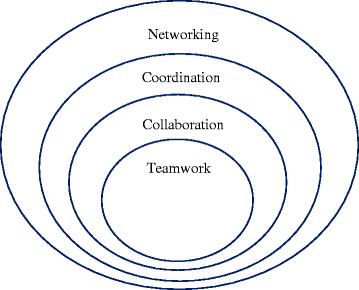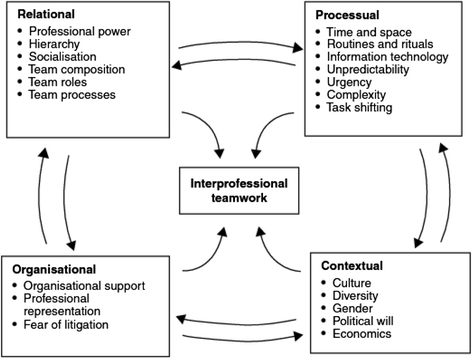Interprofessional work in operating rooms: a qualitative study from Sri Lanka
- PMID: 27596281
- PMCID: PMC5011874
- DOI: 10.1186/s12893-016-0177-7
Interprofessional work in operating rooms: a qualitative study from Sri Lanka
Abstract
Background: A growing body of research shows links between poor teamwork and preventable surgical errors. Similar work has received little attention in the Global South, and in South Asia, in particular. This paper describes surgeons' perception of teamwork, team members' roles, and the team processes in a teaching hospital in Sri Lanka to highlight the nature of interprofessional teamwork and the factors that influence teamwork in this setting.
Methods: Data gathered from interviews with 15 surgeons were analyzed using a conceptual framework for interprofessional teamwork.
Results: Interprofessional teamwork was characterized by low levels of interdependency and integration of work. The demarcation of roles and responsibilities for surgeons, nurses, and anesthetists appeared to be a strong element of interprofessional teamwork in this setting. Various relational factors, such as, professional power, hierarchy, and socialization, as well as contextual factors, such as, patriarchy and gender norms influenced interprofessional collaboration, and created barriers to communication between surgeons and nurses. Junior surgeons derived their understanding of appropriate practices mainly from observing senior surgeons, and there was a lack of formal training opportunities and motivation to develop non-technical skills that could improve interprofessional teamwork in operating rooms.
Conclusions: A more nuanced view of interprofessional teamwork can highlight the different elements of such work suited for each specific setting. Understanding the relational and contextual factors related to and influencing interprofessional socialization and status hierarchies can help improve quality of teamwork, and the training and mentoring of junior members.
Keywords: Interprofessional work; Sri Lanka; Surgical errors; Teamwork.
Figures
Similar articles
-
Barriers and enablers to effective interprofessional teamwork in the operating room: A qualitative study using the Theoretical Domains Framework.PLoS One. 2021 Apr 22;16(4):e0249576. doi: 10.1371/journal.pone.0249576. eCollection 2021. PLoS One. 2021. PMID: 33886580 Free PMC article.
-
Perceptions of interprofessional teamwork in low-acuity settings: a qualitative analysis.Med Educ. 2014 Jun;48(6):583-92. doi: 10.1111/medu.12424. Med Educ. 2014. PMID: 24807434
-
Qualitative Analysis of Effective Teamwork in the Operating Room (OR).J Surg Educ. 2021 May-Jun;78(3):967-979. doi: 10.1016/j.jsurg.2020.09.019. Epub 2020 Nov 5. J Surg Educ. 2021. PMID: 33160940
-
Interventions to facilitate interprofessional collaboration in the operating theatre: A scoping review.J Perioper Pract. 2024 Jan-Feb;34(1-2):6-19. doi: 10.1177/17504589221137978. Epub 2022 Dec 5. J Perioper Pract. 2024. PMID: 36468241 Free PMC article.
-
What fosters or prevents interprofessional teamworking in primary and community care? A literature review.Int J Nurs Stud. 2008 Jan;45(1):140-53. doi: 10.1016/j.ijnurstu.2007.01.015. Epub 2007 Mar 26. Int J Nurs Stud. 2008. PMID: 17383655 Review.
Cited by
-
Advancing leadership in surgery: a realist review of interventions and strategies to promote evidence-based leadership in healthcare.Implement Sci. 2023 May 13;18(1):15. doi: 10.1186/s13012-023-01274-3. Implement Sci. 2023. PMID: 37179327 Free PMC article.
-
The presence and potential impact of psychological safety in the healthcare setting: an evidence synthesis.BMC Health Serv Res. 2021 Aug 5;21(1):773. doi: 10.1186/s12913-021-06740-6. BMC Health Serv Res. 2021. PMID: 34353319 Free PMC article.
-
The "Torment" of Surgical Antibiotic Prophylaxis among Surgeons.Antibiotics (Basel). 2021 Nov 6;10(11):1357. doi: 10.3390/antibiotics10111357. Antibiotics (Basel). 2021. PMID: 34827295 Free PMC article.
-
Italian Validation of the Chiba Interprofessional Competency Scale (CICS29).Acta Biomed. 2020 Mar 13;91(2-S):58-66. doi: 10.23750/abm.v91i2-S.9172. Acta Biomed. 2020. PMID: 32168314 Free PMC article.
-
Influences on surgical antimicrobial prophylaxis decision making by surgical craft groups, anaesthetists, pharmacists and nurses in public and private hospitals.PLoS One. 2019 Nov 14;14(11):e0225011. doi: 10.1371/journal.pone.0225011. eCollection 2019. PLoS One. 2019. PMID: 31725771 Free PMC article.
References
-
- Weller J, Boyd M. Making a difference through improving teamwork in the operating room: A systematic review of the evidence on what works. Curr Anesthesiol Rep. 2014;4:77–83. doi: 10.1007/s40140-014-0050-0. - DOI
MeSH terms
LinkOut - more resources
Full Text Sources
Other Literature Sources



